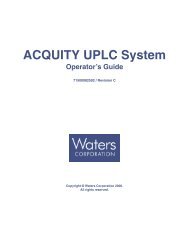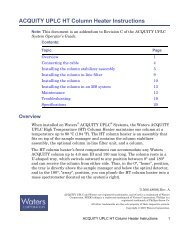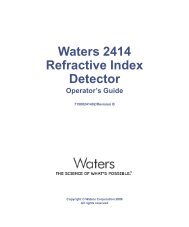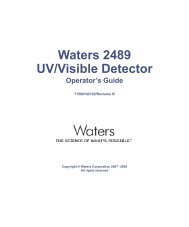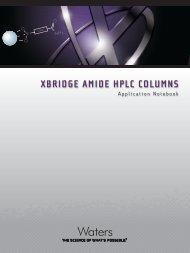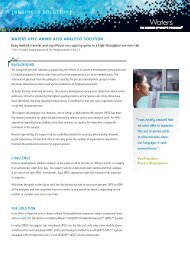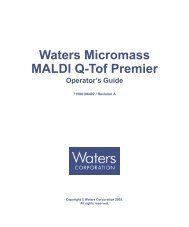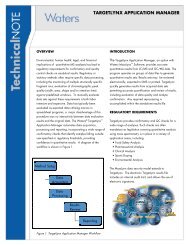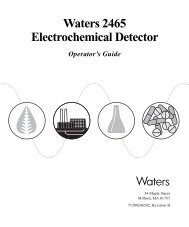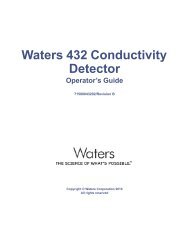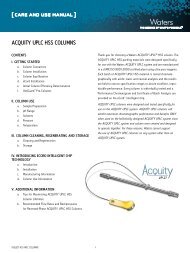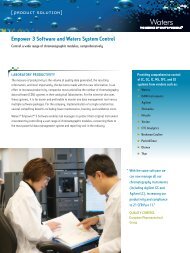Quattro 2 User's Guide, issue 2. 6666533 - Waters
Quattro 2 User's Guide, issue 2. 6666533 - Waters
Quattro 2 User's Guide, issue 2. 6666533 - Waters
You also want an ePaper? Increase the reach of your titles
YUMPU automatically turns print PDFs into web optimized ePapers that Google loves.
<strong>Quattro</strong> II<br />
<strong>User's</strong> <strong>Guide</strong><br />
Sample Inlet Systems<br />
With the exception of the vacuum lock, all of the permanent inlets are located on the<br />
left hand side of the mass spectrometer. The heated GC transfer line passes through a<br />
computer-controlled oven and enters the ion source through a combined inlet flange<br />
along with the reference inlet and CI gas.<br />
The optional particle beam interface, when fitted, is located to the right of the source.<br />
For all other ionisation techniques, and for solids and involatile liquids, sample is<br />
admitted by probe. Apart from the atmospheric pressure techniques (ESP and APcI)<br />
the probe is inserted through a vacuum lock.<br />
Electrospray Co-axial and Triaxial Probes<br />
The CE Probe<br />
The APcI Probe<br />
The electrospray probe allows sample, solvent and a stream of nebulising gas<br />
(nitrogen), to flow into the electrospray source.<br />
The triaxial flow probe is a direct alternative to the standard co-axial electrospray<br />
probe. It incorporates a sheath tube which allows additional solvent to be transported<br />
to the probe tip and mixed co-axially with the sample flow immediately before<br />
spraying.<br />
The CE probe is used to interface capillary electrophoresis (CE) to a standard<br />
electrospray source. The probe utilises a triaxial flow arrangement whereby the CE<br />
eluent is mixed with a suitable make-up solvent at the probe tip, and then nebulised<br />
using nitrogen gas.<br />
For APcI operation sample, along with the solvent and nebulising gas, is admitted to<br />
the mass spectrometer through the heated APcI probe.<br />
The SFC/APcl Interface<br />
The SFC/APcl interface can be configured for both capillary column supercritical<br />
fluid chromatography (cSFC) and packed column SFC (pSFC).<br />
The Reference Inlet<br />
The reference inlet is a simple reservoir inlet system for the introduction of volatile<br />
liquid reference compounds, such as heptacosa (FC43), for the purpose of calibration.<br />
If required this inlet can also be used to introduce volatile liquid samples. Computer<br />
controlled solenoid valves control the introduction of the sample into the source and<br />
the evacuation of the reservoir.<br />
Instrument Description<br />
Page 16



![[ TIPS ] [ ACQUITY UPLC SYSTem QUICk START CARD ] - Waters](https://img.yumpu.com/51427825/1/190x245/-tips-acquity-uplc-system-quick-start-card-waters.jpg?quality=85)
